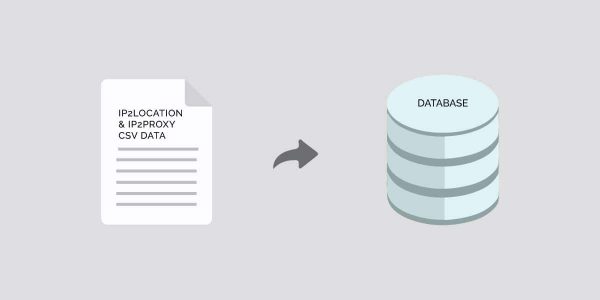Intro
IP2Location and IP2Proxy both provides data in the form of CSV files that can be easily imported into various databases for queries. To make it easier for our users, we have collected all the relevant article links in a single page. We’ll split them into 2 sections. The first one will be for the traditional relational databases while the 2nd is for NoSQL databases.
If you’re in a hurry, click on any of the shortcuts below to jump to the relevant section that you want.
MySQL | IP2Location IPv4 | IP2Location IPv6 | IP2Proxy IPv4 | IP2Proxy IPv6
Microsoft SQL Server (MSSQL) | IP2Location IPv4 | IP2Location IPv6 | IP2Proxy IPv4 | IP2Proxy IPv6
PostgreSQL | IP2Location IPv4 | IP2Location IPv6 | IP2Proxy IPv4 | IP2Proxy IPv6
Oracle Database | IP2Location IPv4 | IP2Location IPv6 | IP2Proxy IPv4 | IP2Proxy IPv6
IBM DB2 | IP2Location IPv4 | IP2Location IPv6 | IP2Proxy IPv4 | IP2Proxy IPv6
SQLite | IP2Location IPv4 | IP2Location IPv6 | IP2Proxy IPv4 | IP2Proxy IPv6
MongoDB | IP2Location IPv4 | IP2Location IPv6 | IP2Proxy IPv4 | IP2Proxy IPv6
Redis | IP2Location IPv4 | IP2Location IPv6 | IP2Proxy IPv4 | IP2Proxy IPv6
Amazon DynamoDB | IP2Location IPv4 | IP2Location IPv6 | IP2Proxy IPv4 | IP2Proxy IPv6
Amazon SimpleDB | IP2Location IPv4 | IP2Location IPv6
Apache CouchDB | IP2Location IPv4 | IP2Location IPv6 | IP2Proxy IPv4 | IP2Proxy IPv6
Apache Cassandra | IP2Location IPv4 | IP2Location IPv6 | IP2Proxy IPv4 | IP2Proxy IPv6
Relational databases
MySQL
One very popular open-source database is MySQL. Below you’ll find articles for importing our CSV data into MySQL tables.
Microsoft SQL Server (MSSQL)
Another popular choice of database made by Microsoft which has a free Express Edition. Below are the articles for importing data into MSSQL.
| How to import DB24 (IPv4) into MSSQL 2017 |
| How to import DB24 (IPv6) into MSSQL 2017 |
| How to import PX8 (IPv4) into MSSQL 2017 |
| How to import PX8 (IPv6) into MSSQL 2017 |
PostgreSQL
This open-source database is used by a lot of famous organizations. Hence, we also provides steps for importing our data.
Oracle Database
This commercial database is highly popular with enterprise customers and as such we want to make it easy for them to load our CSV data with the below articles.
IBM DB2
IBM products such as the DB2 are used by many enterprises, therefore it makes sense for us to provide guides on how to import our data into their tables.
SQLite
SQLite is a popular free database being used daily by many people without them knowing. This is because it’s meant to be embedded in programs such as your web browsers (e.g. Chrome, Firefox & Safari). See below how to import IP2Location & IP2Proxy data into it.
NoSQL databases
MongoDB
MongDB is one of the common NoSQL type databases in use today. See below for guides on importing our data.
Redis
Another commonly used NoSQL is Redis. Steps for data import are below.
Amazon DynamoDB
This proprietary NoSQL comes from Amazon Web Services (AWS). We have included some steps to demonstrate how to import data into DynamoDB.
Amazon SimpleDB
Another NoSQL by AWS which you can easily import our CSV data using the steps below.
| Importing IP2Location data into Amazon SimpleDB and querying with PHP |
| Importing IP2Location data into Amazon SimpleDB and querying with PHP (IPv6) |
Apache CouchDB
The next NoSQL on our list is the open-source CouchDB from Apache. Find import steps below.
Apache Cassandra
The final NoSQL on our list is the open-source Cassandra from Apache. Find import steps below.
What is IP2Location IP Geolocation
IP2Location is a geolocation service that allows you to determine the geographical location of an IP address. It provides information such as the country, region or state, city, latitude, longitude, ZIP code, and more. It is used in various applications, including website analytics, targeted advertising, content localization, fraud prevention, and enhancing user experiences. It helps businesses tailor their online content and services based on a user’s geographic location.
What is IP2Proxy Proxy Detection
IP2Proxy is a proxy detection service that helps identify whether an IP address is associated with a proxy server, VPN, or other types of anonymization services. It provides details about the type of proxy, such as anonymous proxy, public proxy, TOR exit node, and more. It is commonly used for fraud prevention, content access control, security enforcement, and ensuring compliance with regional content restrictions. It allows websites and applications to detect and respond to users who may be attempting to hide their true IP address for various reasons.

